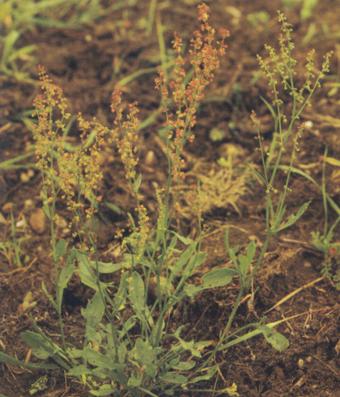Weeds
Rumex acetosella L. - Small Sorrel
Systematic position.
Family Polygonaceae, genus Rumex L.Synonyms.
Acetosella vulgaris (Koch) Fourr., Rumex acetosella subsp. tenuifolius (Wallr.) O. Schwarz, R. tenuifolius (Wallr.) A. Love.Biological group.
Creeping-rooted perennial plant.Morphology and biology.
Weed with creeping rhizomes. Stems numerous, erect, branchy, (5) 10-60 (80) cm tall. Lower leaves with petioles, lanceolate, 1-5 cm in length, 2-1.5 mm in width, with a lanceolate or ovoid-lanceolate top part and 2 smaller blades. Upper leaves almost prostrate, lanceolate or lanceolate-linear. Dioecious plant. Sepals of male flowers reddish yellow, red or purplish, rarely pale green; sepals of female flowers pure red to dark red or purplish. Flowers occur in thin inflorescences, 3 (5)-40 (50) cm long. All parts of perianth erect; external ones shorter and narrower than inner parts. Inner parts of pistillate flowers lack concretions at base. Nutlets smooth, rather shiny, three-edged, pale yellow-brown to slightly reddish brown, 0.9-1.5 x 0.6-1 mm. Optimum temperature for germination is 20-22╓C. Maximum fruitfulness of plant is 10,000 seeds. The seeds germinate from depths of no more than 8-10 cm. They retain germination capacity in the soil for 5 years.Distribution.
Boreal circumpolar species (occurs in the south of North Africa, Turkey, the Caucasus, the Altai and Sayan mountains, Japan and the southern USA); perhaps an indigenous species in some parts of the southern hemisphere; antropochorous plant in major temperate and in some tropical areas. Occurs in the European region of the former USSR (except Lower Volga and Arctic regions), all of Siberia, as an introduced plant in the Far East, and in the Caucasus. Predominant in northern and central regions of the forest zone; more sparse eastward and in the steppe districts.Ecology.
Occurs along field edges, on slopes, in coniferous forests, in sands, on precipices, in fallows, and along roads and railways. In crops of fodder grasses, the weed grows mainly along borders of fields. It prefers light, sandy and podzol soils but populates even very poor soils.Economic significance.
Specialized weed plant of perennial grasses. It is common in the forest zone (in clover and flax crops, in crops requiring tilling between rows, rarely in grain crops, fallows). In steppe and desert zones, the weed is never found. Control measures include cutting the weed before seeds ripen; disking in combination with deep plowing; plowing and deep cultivation using combined aggregates in spring; stubbling to a depth of 12-14 cm right after harvesting (in August, or, in warm autumns, in the beginning of September) and after 2-3 weeks by plows with coulters to a depth of 20-24 cm (in crops requiring tilling between rows and in fallows to a depth of 28-30 cm).Related references.
Agaev, M.G., ed. 1988. Main agricultural weeds in crops of the Leningrad region: Catalogue of VIR world collection. Issue 468. Leningrad: VIR. 112 p. (in Russian).Bazdyrev, G.I., Zotov, L.I. & Polin, V.D. 2004. Weed plants and measuring of wrestling with their in modern agriculture. Moscow: MSHA, 288 p. (in Russian).
Jonsell, B., ed. 2000. Flora Nordica. V. 1. Lycopodiaceae-Polygonaceae. Stockholm: BTJ AB. 344 p.
Komarov, V.L., ed. 1936. Flora USSR. V. 5. Moscow; Leningrad: AN SSSR. 762 p. (in Russian).
Nikitin, V.V. 1983. Weed plants of the USSR flora. Leningrad: Nauka. 454 p. (in Russian).
Ulyanova T.N. 1998. Weeds in the flora of Russia and other CIS states. St. Petersburg: VIR. 233 p. (in Russian).
Volkov, A.N., ed. 1935. The regions of the distribution of the main weeds in the USSR. Moscow; Leningrad: Publishing House of Kolkhoz & Sovkhoz Literature. 153 p. (in Russian).


